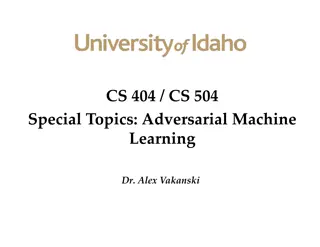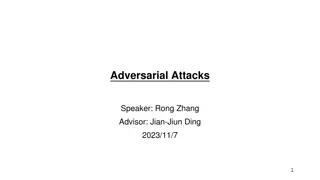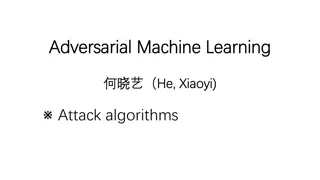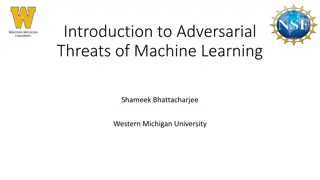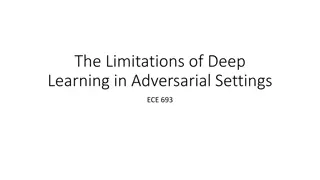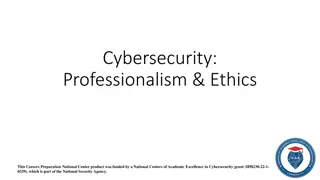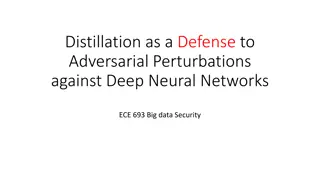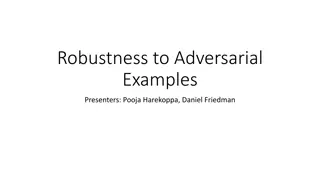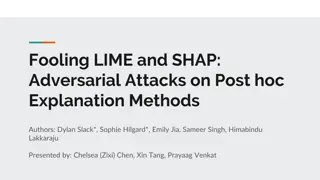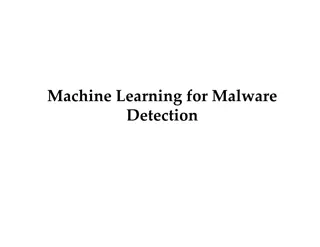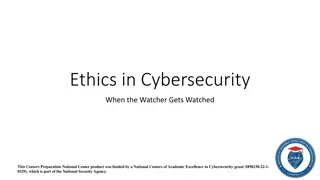Adversarial Machine Learning in Cybersecurity
"Explore the realm of adversarial machine learning in cybersecurity focusing on malware detection and classification. Understand the evolving nature of malware and the threat it poses to computer systems. Discover automated detection versus classification systems and the role of machine learning in combating malware attacks."
Download Presentation

Please find below an Image/Link to download the presentation.
The content on the website is provided AS IS for your information and personal use only. It may not be sold, licensed, or shared on other websites without obtaining consent from the author.If you encounter any issues during the download, it is possible that the publisher has removed the file from their server.
You are allowed to download the files provided on this website for personal or commercial use, subject to the condition that they are used lawfully. All files are the property of their respective owners.
The content on the website is provided AS IS for your information and personal use only. It may not be sold, licensed, or shared on other websites without obtaining consent from the author.
E N D
Presentation Transcript
CS 404/504 CS 404/504 Special Topics: Special Topics: Adversarial Adversarial Machine Learning Machine Learning Dr. Alex Vakanski
CS 404/504, Spring 2023 Lecture 11 Lecture 11 AML in Cybersecurity Part II: Malware Detection and Classification 2
CS 404/504, Spring 2023 Lecture Outline Malware detection and classification Malware analysis systems o Static malware analysis systems o Dynamic malware analysis systems ML models for malware classification o Static and dynamic features o Deep Learning-based malware classification Adversarial attacks on ML-based malware classifiers o Traditional ML models o Deep Learning approaches Kyle Lucke presentation Severi (2021) Explanation-Guided Backdoor Poisoning Attacks Against Malware Classifiers 3
CS 404/504, Spring 2023 Malware Detection and Classification Malware Detection and Classification Malicious software is also known as malware Malware is any kind of software that is specifically designed to disrupt, damage, or gain unauthorized access to a computer system or network Malware is constantly evolving and presents significant threat to computer systems Forces security analysts to keep pace by improving cyber defenses Automated malware detection versus classification Malware detection systems: predict whether an executable file is malware or not a malware o Output: 1 or 0 Malware classification systems: predict the malware type of an executable o Output: 1 to N, where N is the number of different malware families o I.e., malware classification systems differentiate between different kinds of malware (virus, adware, or Trojan), in order to provide a better understanding of their capabilities 4 Gilbert (2020) The Rise of Machine Learning for Detection and Classification of Malware
CS 404/504, Spring 2023 Malware Categories Malware Detection and Classification Depending on the purposes, malware can be divided into various categories Virus: attaches itself to a program and infects a device Worm: self-replicates and propagates copies of itself to other devices over a network Adware: generates/displays unsolicited online advertisements on user s screen Ransomware: locks down an infected device, and demands payment to unlock it Backdoor: allows unauthorized access to functionality Trojan: a class of backdoor malware disguised as legitimate software, to trick users into installing it Bot: distributes malware to other devices, and it is typically part of a network (botnet) Keyloggers: captures keystrokes Rootkit: gains root-level access to conceal the existence of other malware Logic bomb: explodes when a condition occurs 5 Gilbert (2020) The Rise of Machine Learning for Detection and Classification of Malware
CS 404/504, Spring 2023 Malware Analysis Systems Malware Analysis Systems Malware analysis involves dissecting malware to understand how it works, and determine its functionality, origin, and potential impact Malware analysis is essential for any business and infrastructure that responds to cybersecurity incidents Malware analysis systems can be classified into two broad categories Static analysis systems (pre-execution analysis) o Process malware without running it, and extract features to be used for malware detection and classification Dynamic analysis systems (post-execution analysis) o It involves running the malware either in a physical or virtual environment, and searching for indicators of malicious activities Some references also add a class of hybrid analysis systems, that combine static and dynamic analysis 6 Gilbert (2020) The Rise of Machine Learning for Detection and Classification of Malware
CS 404/504, Spring 2023 Portable Executable (PE) File Format Malware Analysis Systems In Windows systems, Portable Executable (PE) is a file format for executables Analogous formats are Executable and Linkable Format (ELF) in Linux and Unix systems, and Mach-O in macOS and iOS Most existing malware targets Windows systems A PE file consists of a number of a header and sections that inform the Windows OS how to manage the executable file 7 Gilbert (2020) The Rise of Machine Learning for Detection and Classification of Malware
CS 404/504, Spring 2023 Portable Executable (PE) File Format Malware Analysis Systems PE file format PE file header o The header of the PE file is composed of additional headers (MS-DOS, PE, and Optional Header) and various tables and fields (Sections Table, Import/Export Address Table) PE file sections o The sections are either code sections (containing machine instructions), data sections (holding variables and constants), or resource sections (holding embedded fonts, images, etc.) 8 Gilbert (2020) The Rise of Machine Learning for Detection and Classification of Malware
The format for a 32-bit PE file header is shown in the figure Note the structure from top to bottom: 1. MS-DOS Header with the DOS Stub 2. PE Header, i.e., COFF (Common Object File Format) Header 3. Optional Header 4. Sections Table Detailed description of the PE format can be found at https://docs.microsoft.com/en- us/windows/win32/debug/pe-format Anderson (2018) EMBER: An Open Dataset for Training Static PE Malware Machine Learning Models
Extracted features from a PE file for ML analysis in the EMBER dataset Note again the header, optional header, imports and exports, sections, etc. Anderson (2018) EMBER: An Open Dataset for Training Static PE Malware Machine Learning Models
CS 404/504, Spring 2023 Static Analysis Systems Malware Analysis Systems Static analysis provides information about the functionality of the file, and it produces a set of signature features (without executing the file) The extracted information is used to predict whether the file is malicious software The disadvantage of static analysis is that the true features of the code may be missed Static analysis can include: Analyzing PE header and sections o PE header provides information about linked libraries and imported/exported functions, as well as contains metadata about the executable file o Strings of characters can contain references to modified files or accessed file paths by the executable (e.g., URLs, domain names, IP addresses, names of loaded DLLs, registry keys, etc.) o Packed/encrypted code that is used by malware developers to make their manipulated files more difficult to analyze can be used for malware detection Disassembling the program translating machine code into assembly language code o Load the executable into a disassembler to translate it into assembly language, and obtain a better understanding of what the program does 11 Gilbert (2020) The Rise of Machine Learning for Detection and Classification of Malware
CS 404/504, Spring 2023 Dynamic Analysis Systems Malware Analysis Systems Dynamic analysis involves executing the program and monitoring its behavior It is typically performed when all available static analysis techniques have been exhausted Dynamic analysis is run in a safe environment on dedicated physical or virtual machines (in order not to expose the users system to unnecessary risks) Physical machines are set up on isolated networks, disconnected from the Internet or any other network, to prevent malware from spreading Virtual machines emulate the functionality of a physical computer, where the OS running on the virtual machine is isolated from the host OS o One limitation is that some malware can detect when they are running in a virtual machine, and they will execute differently than when in a physical machine A related term is sandbox, referring to a physical or virtual environment for running malware, which isolates executables from other system resources and applications o Although sandboxes share characteristics with physical and virtual machines, sandboxes can be more limited (e.g., they can run in the browser), while physical and virtual machines always act as a complete system o For example, online sandboxes are websites where one can submit a sample file and receive a report about its behavior 12 Gilbert (2020) The Rise of Machine Learning for Detection and Classification of Malware
CS 404/504, Spring 2023 ML-based Malware Classification ML-based Malware Classification ML-based systems for malware detection and classification employ a set of extracted features from executable files As we mentioned before, unlike the ML models in Computer Vision that employ the intensity of image pixels for image classification, segmentation, or object detection tasks, ML models for malware classification employ a great variety of different features The extracted features are used for training an ML model, and understandably, the trained model is afterwards used for detection or classification of new files In the remainder of the lecture, we will use the term classification or classifier to describe both ML models for detection and classification of malware Based on the inputs used for malware classification, the ML-based systems can be broadly categorized into: Raw-binary classifiers - use raw byte content from executables as input features Feature-based classifiers - use either static or dynamic features, obtained via static or dynamic malware analysis 13 Gilbert (2020) The Rise of Machine Learning for Detection and Classification of Malware
CS 404/504, Spring 2023 Features for Malware Classification ML-based Malware Classification The figure shows static and dynamic features that are commonly used for ML- based malware classification 14 Gilbert (2020) The Rise of Machine Learning for Detection and Classification of Malware
CS 404/504, Spring 2023 Static Features for Malware Classification Static Features for Malware Classification Static features In Windows systems, static features are extracted from either the PE file header and sections, or assembly language source file (obtained after disassembling the file) In Android systems, static features are extracted from the disassembled APK o Various disassembler tools for Windows and Android are available Strings sequence of characters, related to URLs, IP addresses, accessed file paths, registry keys, or names of modified files by the executable Ye et al. (2008) used extracted strings from PE files as input features to an SVM ensemble with bagging model for malware detection Byte n-grams sequence of n bytes in PE header or the assembly language code An n-gram is a sequence of n adjacent items in sequential data A large number of sequences of n bytes (n ranging from 1 to 8) are used as input features for ML model training Different ML models (Decision Trees, Random Forests, Deep Belief Nets) have been implemented using byte n-grams, e.g., by Jain and Meena (2011), Yuxin et al. (2019) Challenges include the large number of n-grams for each file (which often requires reducing the dimensionality of the feature vectors) 15
CS 404/504, Spring 2023 Static Features for Malware Classification Static Features for Malware Classification Opcode (mnemonic) n-grams n consecutive opcodes (i.e., operational code instructions) in the assembly language source code Assembly instructions are composed of an operational code and operand o E.g., instruction sequence: call sub_401BCD , add eax 1 , mov ebx ebx o 3-gram opcode: CALL-ADD-MOV Malware samples from the same family often use the same opcodes Santos et al. (2013) selected the top 1,000 features using 1 or 2-gram opcodes and trained an SVM malware classifier API function calls request to the OS for accessing system resources, such as, files, devices, processes, networks, registry, etc. Application Programming Interfaces (API) function calls are very discriminative features, as they can provide key information to reveal the behavior of malware o E.g., certain sequences of API function calls are often found in malware, but rarely in benign files Ahmadi et al. (2016) used the frequency of 794 API function calls to develop an ML system for classifying malware into families 16 Gilbert (2020) The Rise of Machine Learning for Detection and Classification of Malware
CS 404/504, Spring 2023 Static Features for Malware Classification Static Features for Malware Classification Entropy-based features indicate the statistical variation of bytes in a file, and are used to detect compressed or encrypted segments of codes in executables Malware developers use compression and encryption to conceal malicious segments of code from static analysis Files with compressed or encrypted segments have higher entropy than native code Structural entropy represents an executable file as a stream of entropy values, where each value indicates the entropy over a small chunk of code (see the figure below) A similarity score of structural entropies is used for malware classification, e.g., by Sorokin and Jun (2011) Ramnit family malware Gatak family malware 17 Gilbert (2020) The Rise of Machine Learning for Detection and Classification of Malware
CS 404/504, Spring 2023 Static Features for Malware Classification Static Features for Malware Classification IMG-based features visualize the binary content of an executable as a gray- scale image This is achieved by interpreting every byte as one pixel of a gray-scale image, and organizing the array of bytes in an executable as a 2-D image Two malware families are shown as gray-scale images in the figure (note that the two families have a distinct image representation) Nataraj et al. (2011) used k-Nearest Neighbors to classify malware families Ramnit family malware Lollipop family malware 18 Gilbert (2020) The Rise of Machine Learning for Detection and Classification of Malware
CS 404/504, Spring 2023 Static Features for Malware Classification Static Features for Malware Classification Function call graph is a directed graph in which the nodes represent the functions of a program, and the edges symbolize function calls Kinable et al. (2011) developed an approach for clustering malware based on the structural similarities between function-call graphs Control flow graph is a directed graph in which the nodes represent subroutines in programs, and the edges represent control-flow paths The control-flow graph is a representation of all the paths through different subroutines that can be traversed during a program s execution Faruki et al. (2012) used a Random Forest classifier for detecting malware using control-flow graphs of various API calls 19 Gilbert (2020) The Rise of Machine Learning for Detection and Classification of Malware
CS 404/504, Spring 2023 Dynamic Features for Malware Classification Dynamic Features for Malware Classification Dynamic features are extracted from the execution of malware at runtime Memory and registers usage values stored in the memory and different registers during the execution can distinguish benign from malicious programs Ghiasi et al. (2015) monitored the memory content and register values before and after each invoked API call They used similarity scores between the benign and malicious files in a training set to train an ML model for malware detection Instruction traces sequence of processor instructions called during the execution of a program Dynamic instruction traces are more robust indicators of the program s behavior than static traces, since compression and encryption can obfuscate code instructions from static analysis o Also, dynamic instruction traces are ordered as they are executed, while static instruction traces are ordered as they appear in the binary file Carlin et al. (2017) analyzed traces of opcodes to detect malware by Random Forest and Hidden Markov Model classifiers 20 Gilbert (2020) The Rise of Machine Learning for Detection and Classification of Malware
CS 404/504, Spring 2023 Dynamic Features for Malware Classification Dynamic Features for Malware Classification Network traffic monitoring the traffic entering and exiting the network can provide helpful information to detect malicious behavior E.g., when malware infects a host machine, it may establish communication with an external server to download updates, other malware, or leak private and sensitive information from the host machine Bekerman et al. (2015) extracted 972 features from the network traffic, and used them for developing Decision Tree and Random Forest malware classifiers API call traces traces for accessing file systems, devices, processes, threads and error handling, and also to access functions such as the Windows registry, manage user accounts, etc. Uppal et al. (2014) proposed traditional ML-based classifiers using n-grams of features extracted from traces of invoked API calls 21 Gilbert (2020) The Rise of Machine Learning for Detection and Classification of Malware
CS 404/504, Spring 2023 Adversarial Attacks on ML Malware Classifiers Adversarial Attacks on ML-based Malware Classifiers Next, a short overview of the adversarial attacks on ML-based models for malware classification is presented A more detailed review can be found in Rosenberg et al. (2021) Adversarial Machine Learning Attacks and Defense Methods in the Cyber Security Domain AML attacks approaches can generally be divided into two groups: Attacks on traditional ML-based malware classifiers Attacks on deep learning-based malware classifiers Challenges for adversarial attacks on malware classifiers ML classifiers typically employ a set of features extracted from malware and goodware, which are converted into numerical vectors and are used for training an ML model Generating adversarial samples by applying perturbations to the numerical features vectors may result in nonfunctional files or crashes o Hence, it is required to carefully select the features to be manipulated in order to preserve the functionality of the manipulated files 22
CS 404/504, Spring 2023 Attacks on Traditional ML Models Adversarial Attacks on Traditional ML-based Malware Classifiers Ming et al. (2015) Replacement Attacks: Automatically Impeding Behavior- Based Malware Specifications This work introduced an evasion white-box attack o The adversary s goal is to alter malware files, in order to result in misclassification by the ML model as goodware files at inference time The authors modified malware code by replacing API calls with functionality- preserving API calls The attack was employed to evade an ML classifier using Function-Call Graphs features as inputs 23 Rosenberg (2021) AML Attacks and Defense Methods in the Cyber Security Domain
CS 404/504, Spring 2023 Attacks on Traditional ML Models Adversarial Attacks on Traditional ML-based Malware Classifiers Xu et al. (2020) MANIS: Evading Malware Detection System on Graph Structure Evasion white-box attack against Android APK malware classifiers Uses n-strongest nodes and FGSM in a Function-Call Graph to generate perturbed samples Anderson et al. (2018) Learning to Evade Static PE Machine Learning Malware Models via Reinforcement Learning Evasion black-box attack that employs static features against a Gradient Boosted Decision Tree classifier A reinforcement learning approach was used to generate perturbed samples, by learning the sequence of operations that are likely to result in detection evasion 24 Rosenberg (2021) AML Attacks and Defense Methods in the Cyber Security Domain
CS 404/504, Spring 2023 Attacks on Traditional ML Models Adversarial Attacks on Traditional ML-based Malware Classifiers Data poisoning attacks One should note that data poisoning attacks are more challenging in cybersecurity, because they require injecting samples into the training set of the malware classifier But they can have significant consequences, when the adversary has the ability to tamper with the training set Siciu et al. (2018) When Does Machine Learning FAIL? Generalized Transferability for Evasion and Poisoning Attacks The attack is against a linear SVM classifier for Android malware detection Data poisoning was done by adding static features (API calls, URL requests) to benign samples Munoz Gonzalez et al. (2017) Towards Poisoning of Deep Learning Algorithms with Back-gradient Optimization Transferability black-box attack, requires read and add access to the training set Against Logistic Regression and an NN model for spam and ransomware detection A substitute model was trained and poisoned, and by employing transferability, it was demonstrated that the poisoned samples were effective against the target classifiers 25 Rosenberg (2021) AML Attacks and Defense Methods in the Cyber Security Domain
CS 404/504, Spring 2023 Attacks on Traditional ML Models Adversarial Attacks on Traditional ML-based Malware Classifiers Attacks on PDF classifiers Note that PDF malware is less common, and most malware are PE files Srndic and Laskov (2014) Practical Evasion of a Learning-Based Classifier: A Case Study Evasion white-box attack, against Random Forest classifier (named PDFRATE) that uses static binary strings as features for detecting malicious PDF files The attack adds new strings features to malicious PDF files, to evade being detected as malware by PDFRATE Li et al. (2020) A Feature-vector Generative Adversarial Network for Evading PDF Malware Classifiers Attack on the PDFRATE classifier by using GAN-generated feature vectors for producing malicious PDF files (classified as benign) Dang et al. (2017) Evading Classifiers by Morphing in the Dark White-box attack against SVM and Random Forest PDF malware classifiers A hill-climbing optimization approach was used to minimize the score for the rate of feature modifications from malicious and benign PDFs 26 Rosenberg (2021) AML Attacks and Defense Methods in the Cyber Security Domain
CS 404/504, Spring 2023 Deep Learning for Malware Classification Deep Learning Approaches for Malware Classification Besides traditional ML approaches for malware classification that rely on manually selected features based on expert knowledge, recent work has emerged that applied Deep Learning methods for malware classification DL approaches are more successful in detecting unseen and unsigned malware Numerous DL approaches have been introduced, employing raw bytes and static/dynamic malware input features and various network architectures Encoder architectures have often been used in these approaches for extracting salient features and dimensionality reduction of n-gram features Convolutional NN models employing IMG-based features and raw bytes-based features have been applied for malware classification Recurrent NN models have been introduced for capturing dependencies in API call traces, network traffic, and instruction traces Architectures with both convolutional and recurrent layers have also been developed for dealing with both the spatial and sequential nature of static and dynamic features in executables 27 Gilbert (2020) The Rise of Machine Learning for Detection and Classification of Malware
CS 404/504, Spring 2023 Attacks on Deep Learning Models Adversarial Attacks on Deep Leaning-based Malware Classifiers Attacks on Deep Learning classifiers using raw bytes (raw-binary classifiers) A limitation of these approaches is that raw byte content is rarely used as features in the next generation anti-virus (NGAV) products Kreuk et el. (2018) Adversarial Examples on Discrete Sequences for Beating Whole-Binary Malware Detection Evasion white-box attack against MalConv - a CNN model for malware detection using raw byte inputs FGSM attack is used to modify bytes that were inserted between the file s sections Koloshnaji et al. (2018) Adversarial Malware Binaries: Evading Deep Learning for Malware Detection in Executables Implemented a similar attack to Kreuk et al. (2018) Analyzed the byte features that are the most impactful for the attack, found that most of these features belong to the PE header Siciu et al. (2018) Exploring Adversarial Examples in Malware Detection Developed a related black-box attack, where adversarial files were created by appending bytes from benign PE headers to malware 28 Rosenberg (2021) AML Attacks and Defense Methods in the Cyber Security Domain
CS 404/504, Spring 2023 Attacks on Deep Learning Models Adversarial Attacks on Deep Leaning-based Malware Classifiers Attacks on Deep Learning classifiers using static or dynamic features (feature- based classifiers) Abusnaina et al. (2019) Adversarial Learning Attacks on Graph-based IoT Malware Detection Systems Evasion white-box attack, against a CNN-model for IoT malware classification Uses Control-Flow Graph features of the malware disassembly source code Malicious samples were generated by concatenating CFGs of benign samples Hu and Tan (2017) Black-Box Attacks against RNN based Malware Detection Algorithms Evasion white-box attack, against an LSTM classifier trained on the dynamic API call traces of the malware A GAN model with RNN layers was used to generate invalid API calls, which were inserted into the original API call traces 29 Rosenberg (2021) AML Attacks and Defense Methods in the Cyber Security Domain
CS 404/504, Spring 2023 Attacks on Deep Learning Models Adversarial Attacks on Deep Leaning-based Malware Classifiers Rosenberg et al. (2020) Generating End-to-End Adversarial Examples for Malware Classifiers Using Explainability Black-box attack using 2,351 static features extracted from PE files Transferability in AML is employed, where a substitute ML model is first trained, and it is hoped that the adversarial samples will be transferred to a target ML model Used feature importance approaches from explainable ML to select the minimal set out of 2,351 features that have high impact on the malware classification Algorithm: 1) Train a substitute NN model on a training set believed to accurately represent the attacked ML-based malware classifier 2) Select a malware executable file that needs to bypass the attacked malware classifier 3) Use explainable ML algorithm to calculate features importance for the classification of the malware on the substitute model 4) For each feature in the set of features that are the easiest to modify, change the feature using the list of predefined values, and select the value that result in the lowest confidence score by the substitute malware classifier 5) Repeat until a benign classification is achieved by the target malware classifier 30 Rosenberg (2021) AML Attacks and Defense Methods in the Cyber Security Domain
Explanation-Guided Backdoor Poisoning Attacks Against Malware Classifiers Author: Severi et al. Presented by: Kyle Lucke 31
Background 3 main types of poisoning attacks: 1. Availability poisoning - aims to reduce model accuracy 2. Targeted poisoning attacks - induce model to misclassify single instance at inference time 3. Backdoor attacks - a. goal: inject backdoor pattern into learned representation of model b. Clean label/dirty label - SHapley Additive exPlantations (SHAP) - Trains surrogate linear model to determine how important each feature is to the final model prediction: 32
Threat model - Adversary s goals: - F(Xb) = y: generate backdoored benign binaries, insert into training data, thereby poisoning model - Fb(Xb) = yb:then attacker injects backdoor into malicious binary, classified as benign - Adversary s capabilities 34
Explanation guided backdoor attacks 2 strategies for creating backdoor: 1. Search for areas of weak confidence near the decision boundary, where watermark can overwhelm existing weak evidence 2. Subvert areas that are already heavily oriented toward goodware so that density of backdoor sub-space overwhelms the signal from other nearby samples Key for allbackdoor attacks is to choose features with a high degree of leverage over the model s decisions SHAP provides model agnostic way to determine how strongly a particular feature influences model decision - Positive SHAP values indicate features which push model towards malware decision - Negative SHAP values indicate features which push model towards goodware or benign decision - Low confidence areas correspond to SHAP values near zero - - 35
Building blocks - feature selection - To reduce possibility of detection, attacker wants to minimize: - Size of trigger (number of manipulated features) - Size of poisoned dataset Feature selection - LargeSHAP - Sum SHAP values over feature columns - Large positive values => important to malware decisions - Large negative values => important to goodware decisions - Small values => indicate areas of weak confidence - LargeAbsSHAP - Sum absolute value of SHAP values - Captures overall importance of features of model, regardless of orientation - 36
Building Blocks - value selection - Once we identify feature subspace for embedding backdoor, need to choose values that make up that trigger Want to select these values based on notion of density in the subspace - Sparse, weak confidence areas (gives large leverage over decision boundary) - Points in dense areas to blend in with surrounding background data Value selection - MinPopulation (e.g. values that occur with least frequency in dataset) - Select sparse values - Provides strong leverage over decision boundary - CountSHAP - Chooses values with high density of goodware aligned data points - Allows trigger to blend in with background goodware data - - 37
Building Blocks - value selection (cont.) - Value selection - CountAbsSHAP - CountSHAP values - Blend well - But, have to fight against background data Lead authors to propose CountAbsSHAP - Gives feature values which have low confidence in determining class - 38
Attack Strategies - independent selection - Searches for areas of weak confidence near decision boundary - Use LargeAbsSHAP to select most important features - Then, use either - MinPopulation - Ensures select highest leverage features and values with most sparsity - CountAbsSHAP - Tries to balance blending trigger and finding values that have weak confidence in data Attack strongly affects decision boundary - easy to mitigate against due to how unique the watermarked data points are - 39
Attack Strategies - greedy combined selection - More carefully blends watermark with background dataset Use greedy algorithm to conditionally select new features and values such that those values are consistent with existing goodware-oriented points Use LargeSHAP to select most goodware oriented features Use CountSHAP to find highest density, goodware oriented values - - - 40
Results - Datasets (all malware classification) - EMBER - 2351-dimensional feature vector from 1.1 million Portable windows Executables - All malicious binaries were reported as such by at least 40 AV engines - Contaigo - PDF - Drebin - Android app files Models - LightGBM - gradient boosting model released with EMBER - EmberNN - feedforward NN Metrics - Acc(Fb, Xb) - accuracy of backdoored model on backdoored samples - Goal: to REDUCE this value - Acc(Fb, X) - accuracy of backdoored model on clean test set - FPb - false positives of backdoored model - - 41
Mitigation Strategies - Spectral Signature - Use SVD of benign samples over reduced feature space - compute outlier score by multiplying top right singular vector - Filter out samples with the highest 15% of scores HDBSCAN - Cluster based method - Cluster examples using reduced feature set - Compute silhouette scores on cluster to compute intra-cluster similarity of sample - Filter out samples from each cluster with probability related to cluster silhouette score Isolation Forest - Unsupervised anomaly detection algorithm - Based on identifying rare and different points instead of building model of normal sample - Intuition - approach will identify watermarked samples as outliers due to similarity - As opposed to very diverse background points - - 46
Questions? 48
CS 404/504, Spring 2023 Additional References Rosenberg et al. (2021) Adversarial Machine Learning Attacks and Defense Methods in the Cyber Security Domain, https://arxiv.org/abs/2007.02407 Gilbert et al. (2020) The Rise of Machine Learning for Detection and Classification of Malware: Research Developments, Trends and Challenges, link Kaspersky Lab (2020) Machine Learning Methods for Malware Detection, link 1. 2. 3. 49




